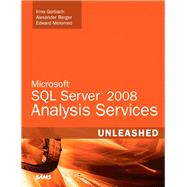
Alexander Berger was one of the first developers to work on OLAP systems at Panorama, prior to their purchase by Microsoft. After the acquisition, Alexander led the development of Microsoft OLAP Server through all of its major releases prior to SSAS 2008. Currently, Alexander leads the Business Intelligence department for Microsoft adCenter. He is one of the architects of OLEDB for the OLAP standard and MDX language, and holds more than 30 patents in the area of multidimensional databases.
Edward Melomed is one of the original members of the Microsoft SQL Server Analysis Services team. He arrived in Redmond as part of Microsoft’s acquisition of Panorama Software Systems, Inc., which led to the technology that gave rise to Analysis Services 2008. He works as a program manager at Microsoft and plays a major role in the infrastructure design for the Analysis Services engine.
| Introduction | p. 1 |
| Introduction to Analysis Services | |
| Introduction to OLAP and Its Role in Business Intelligence | p. 7 |
| The Multidimensional Data Model | p. 8 |
| The Conceptual Data Model | p. 9 |
| The Application Data Model | p. 9 |
| The Physical Data Model | p. 9 |
| Unified Dimensional Model | p. 11 |
| Basic Concepts | p. 13 |
| Multidimensional | |
| Space | p. 17 |
| Describing Multidimensional Space | p. 17 |
| Dimension Attributes | p. 20 |
| Cells | p. 22 |
| Measures | p. 22 |
| Aggregation Functions | p. 23 |
| Subcubes | p. 24 |
| Client/Server Architecture and Multidimensional Databases: An Overview | p. 27 |
| Two-Tier Architecture | p. 28 |
| One-Tier Architecture | p. 29 |
| Three-Tier Architecture | p. 30 |
| Four-Tier Architecture | p. 31 |
| Distributed Systems | p. 32 |
| Distributed Storage | p. 32 |
| Thin Client/Thick Client | p. 32 |
| Creating Multidimensional Models | |
| Conceptual Data Model | p. 37 |
| Data Definition Language | |
| Table of Contents provided by Publisher. All Rights Reserved. |
The New copy of this book will include any supplemental materials advertised. Please check the title of the book to determine if it should include any access cards, study guides, lab manuals, CDs, etc.
The Used, Rental and eBook copies of this book are not guaranteed to include any supplemental materials. Typically, only the book itself is included. This is true even if the title states it includes any access cards, study guides, lab manuals, CDs, etc.